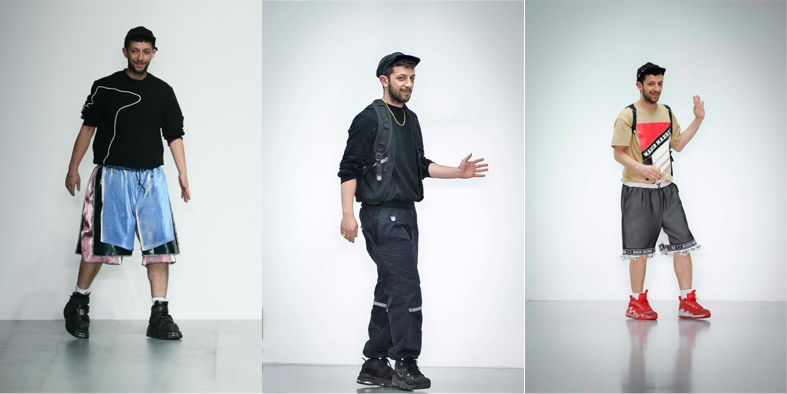Just as a grime MC would begin their freestyle stating their London postcode, so does Mazhar through his fearlessly designed street-wear. The designers name ‘Nasir Mazhar’ defiantly monograms reworked street staples, from tracksuit bottoms to 5 panel caps. It’s clear from taking one look at his collections the urban inspirations Mazhar takes, and how he uses them.

Mazhar, raised in Leytonstone and from a Turkish-Cypriot family, embodies in himself a multicultural London. This natural combination of influences is reflected in the eclecticism of clothes that he creates. Pink holographic cuts of material are shamelessly paired with black fur and thigh high boots, which are neatly adorned with cornrows and kiss curls slicked down with Vaseline and a toothbrush (AW14). It’s clear that Mazhar is trying to capture a specific essence of London. A time where So Solid dominated the airwaves. A time where sending music via Bluetooth on your Sony Erricson phone seemed like a perfectly quick and easy way to give your mate the entire of Dizzee Rascal’s ‘Boy in Da Corner’.
This connection to music is something Mazhar is well accustomed to; routinely teaming up with Skepta and local DJ’s (Logan Sama for his latest show), highlighting music’s influence on his fashion. For Mazhar, music seems to set the tone and gives a kind context for his work. His clothes are born from that local music scene. He reminisces about a local club in Leytonstone, “More Fire Crew played … they used to have all sorts playing there, and that was the closest to a club we’d come at 16. That was garage – 100 percent garage – and nothing else.” This kind of music has a distinct pack mentality, a clear sense of community and belonging. If you think of the way grime and garage crews (think Heartless Crew, BBK or Newham Generals) rolled with about 10 men minimum, it makes sense that Mazhar’s locally sourced models look like a gang themselves. Uniform, united and rebellious. Winged eyeliner applied so sharply it could cut your worst enemy.
Mazhar with Skepta in the recording studio (Img: clashmusic.com)
Just like this, Mazhar illustrates just how music and fashion can be so adjoined to one another. He collaborated with Skepta to create a bespoke made soundtrack for his SS15 shows and also allowed the grime demi-god to walk on his catwalk. The grime and garage marriage with his clothes is natural and organic. In an interview about his clothing line he speaks of music in as much detail as he regards his creations, “My taste in music all came from my older brother. …I was well into jungle, happy hardcore, drum ‘n’ bass – those “World Dance” and “Helter Skelter” tape packs – and then R&B as well.” This mish-mash of musical influences manifest themselves in baggy muay-thai style shorts topped off with combative headwear – no surprise given his background in millinery.
The clothes themselves speak volumes and don’t only draw influence from music. Mazhar talked of the negatively portrayed ASBO culture of the early noughties to Vice, “If you wore a tracksuit, that whole look was completely discarded and branded as chav culture, and everything that came along with that fucking word ‘chav’ was like cheap, trashy, slutty, slobby, common. There’s nothing good about being called a chav, so why would anyone want to look like that? That look was ripped to pieces, and it kind of worked – now you can’t tell who’s who any more.” He almost laments for the time before the homogenisation of street style. What used to be perceived as ‘chavvy’ at least seemed to have some kind of integrity and authenticity. Mazhar is able to transform a cultural moment into what is essentially an art form. His work appears to carry a lot more of a cultural weight then one might first think.
Nazir Mazhar revels what is unpretentious. He’s taking the former ridicule of ‘yob culture’ and is making it into a statement that can’t be ignored. After his SS15 show he held an after party at the Metropolis strip club in Hackney. In his dark, purple and red lit anti-paradise, skimpily clad dancers twirled high poles with nothing but his notoriously monogrammed name covering them. He screams ‘it’s all about power to the people’ down the camera. Where society often looks down on this culture as ‘low culture’, branding it as ‘slutty’, ‘common’ or ‘tacky’, Mazhar is the most happiest. Deep basslines, dimly lit club corners and low hoods are all part of the aesthetic. After all his clothes are made -and proudly- for the street and the after party rather than the catwalk.
Elsbeth Olaniran






